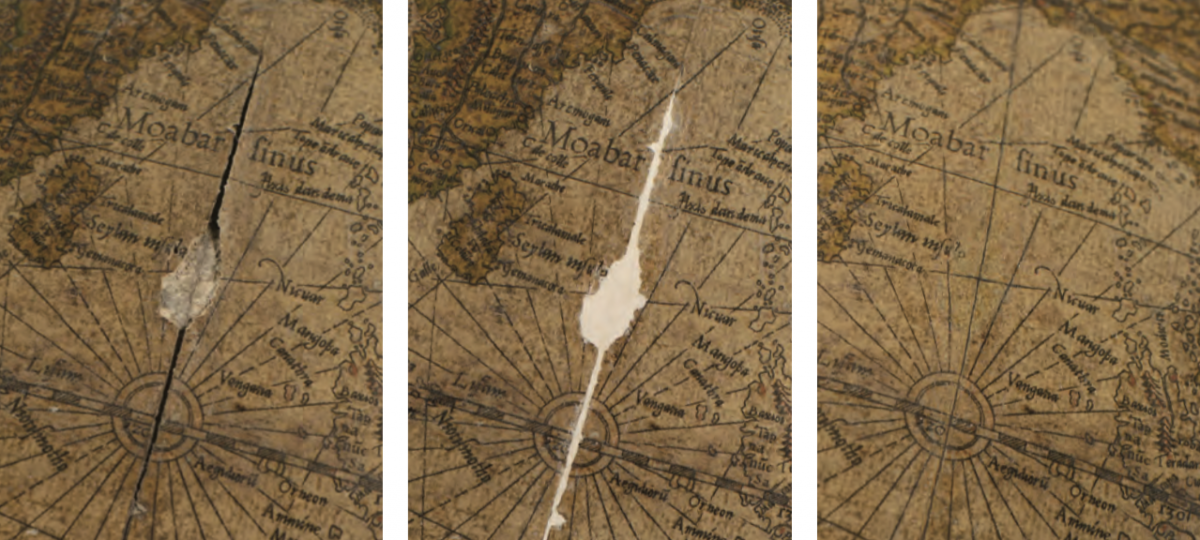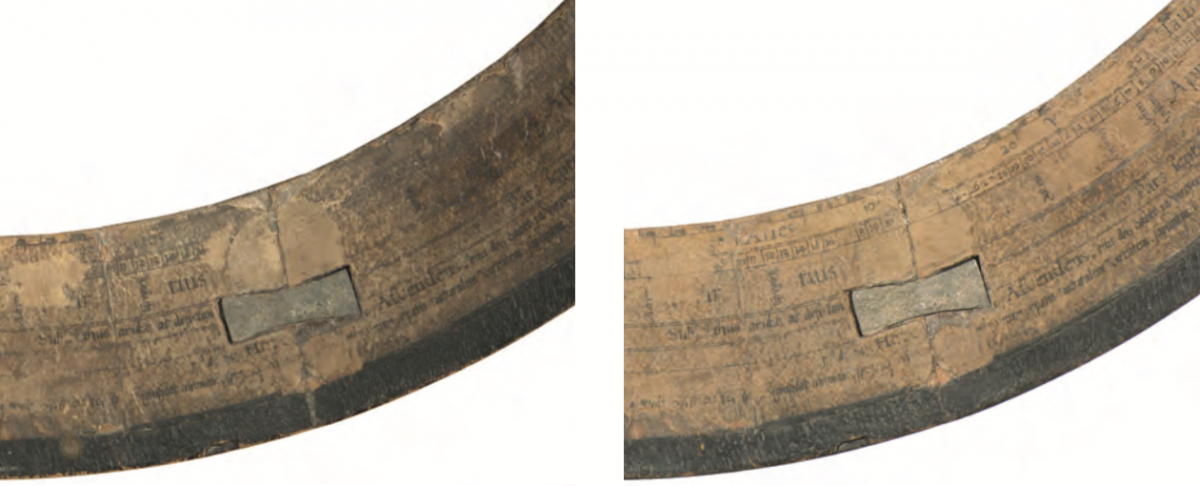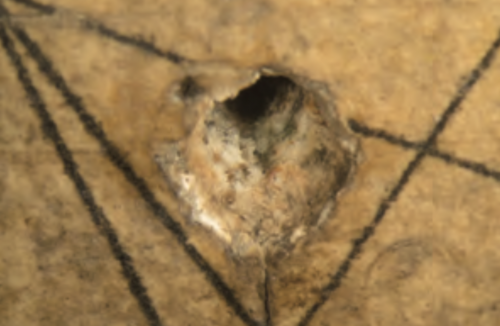Restoration and conservation
The globes were restored and conserved by Margaux Genton, an assistant restorer MA at SIK|ISEA (Zurich) during 2015. Here are the main comments concerning this taken from her final report.

Stages of restoration: left, nick and peeling before treatment; centre: condition after cleaning and sealing; right, condition after restoration and touching up of fillings. (Ill. 25, SIK|ISEA report)
The layers of paper were first of all dusted off using a soft brush, then gently wiped with a latex sponge (which picks up dirt without water). Next the surface was cleaned using moist Japanese vellum compresses and/or cotton swabs.
Various aqueous gels were used for cleaning :
- methylcellulose, Benecel A4C and Methocel A4M (Kremer) 0.5-2% in demineralised water
- Funori (Kremer) 0.5-1% in demineralised water
- Funori and methylcellulose mixtures
The bits of paper that had come unstuck were re-glued with methylcellulose, Methocel A4M or Benecel A4C 0.5-3%, depending on the required viscosity.
The unvarnished areas of paper were singled out using methylcelluose and then protected with a thin coat of dammar varnish dissolved in sangayol (Kremer).
Next, the missing spots were touched up with water colours, gouache (Schmincke) or dammar and dry pigments (Kremer).
In the places where there was no more paper on the spheres, the gaps were first of all filled with edible gelatine sealant (8% in demineralised water) laden with Champagne chalk (6 parts), Bologna chalk (4 parts) and kaolin (1 part). These fillings were then touched up the same way, first with water colours and/or gouache then with pigments and dammar resin. Sometimes Mussini colours (Deffner and Johann) were also used, made of finely ground resin-oil-based pigments, but only on the sealed spots.

The horizon ring of the CG before (left) and after (right) restoration, which involved cleaning, re-gluing detached paper, sealing nicks and other touch-ups. (Ill. 29, SIK|ISEA report)
The stands were first of all dusted off and then cleaned with a Wishab sponge and lukewarm demineralised water. The badly soiled areas (feet and compasses) were cleaned using cotton swabs.
The large nicks and the particularly visible smaller ones were touched up with gouache, dry pigments and dammar pigments dissolved in sangayol. The worn black edges were also lightly touched up with the same colours.
To reposition the spheres as best as possible in relation to the horizon rings, small pieces of wood were inserted in the notches for the meridians, thereby forcing the spheres towards the side opposite the rubbing. Unfortunately they are still off-centre in the horizon rings, so considerable care is needed when they are rotated. The meridians can moreover be pushed manually away from the area of rubbing during rotation.
To position the terrestrial globe better, the small cylindrical support holding up the meridian was also corrected by sawing 5 mm into one side of the notch and compensating on the other side with a small piece of balsa wood coloured with brown gouache.

Layers visible in a hole in the TG. The cavity was simply covered over with coloured Japanese vellum. (Ill. 44, SIK|ISEA report)
The holes left by the samples taken for the C14 tests were sealed and touched up, but a small cavity was deliberately left on the terrestrial globe.
Similarly, the hole in which the printing press character was discovered (just below the equator in present-day Gabon at longitude 40°) was left unsealed. It was simply covered over with coloured and varnished Japanese vellum.
Find out more
- Les globes de Mercator de l’Université de Lausanne. Observations matérielles. Constat d’état. Rapport de conservation-restauration : The Mercator globes of the University of Lausanne. Material observations. Condition report. Report on conservation-restoration, Workshop and laboratory of the Swiss Institute for Art Research SIK|ISEA, Ref. No. 141110 0002: 01/02, October 2015, Margaux Genton, Zurich.